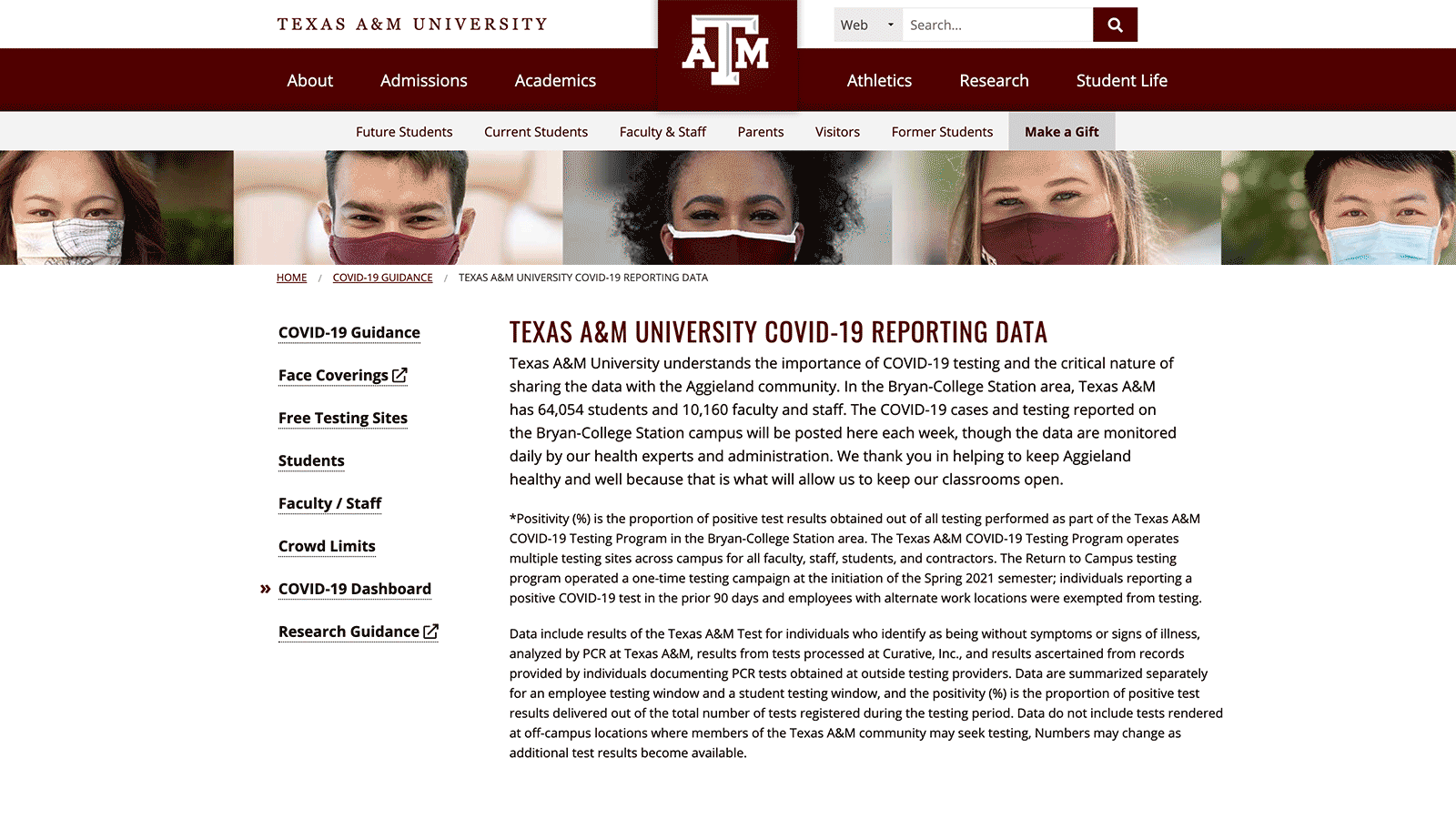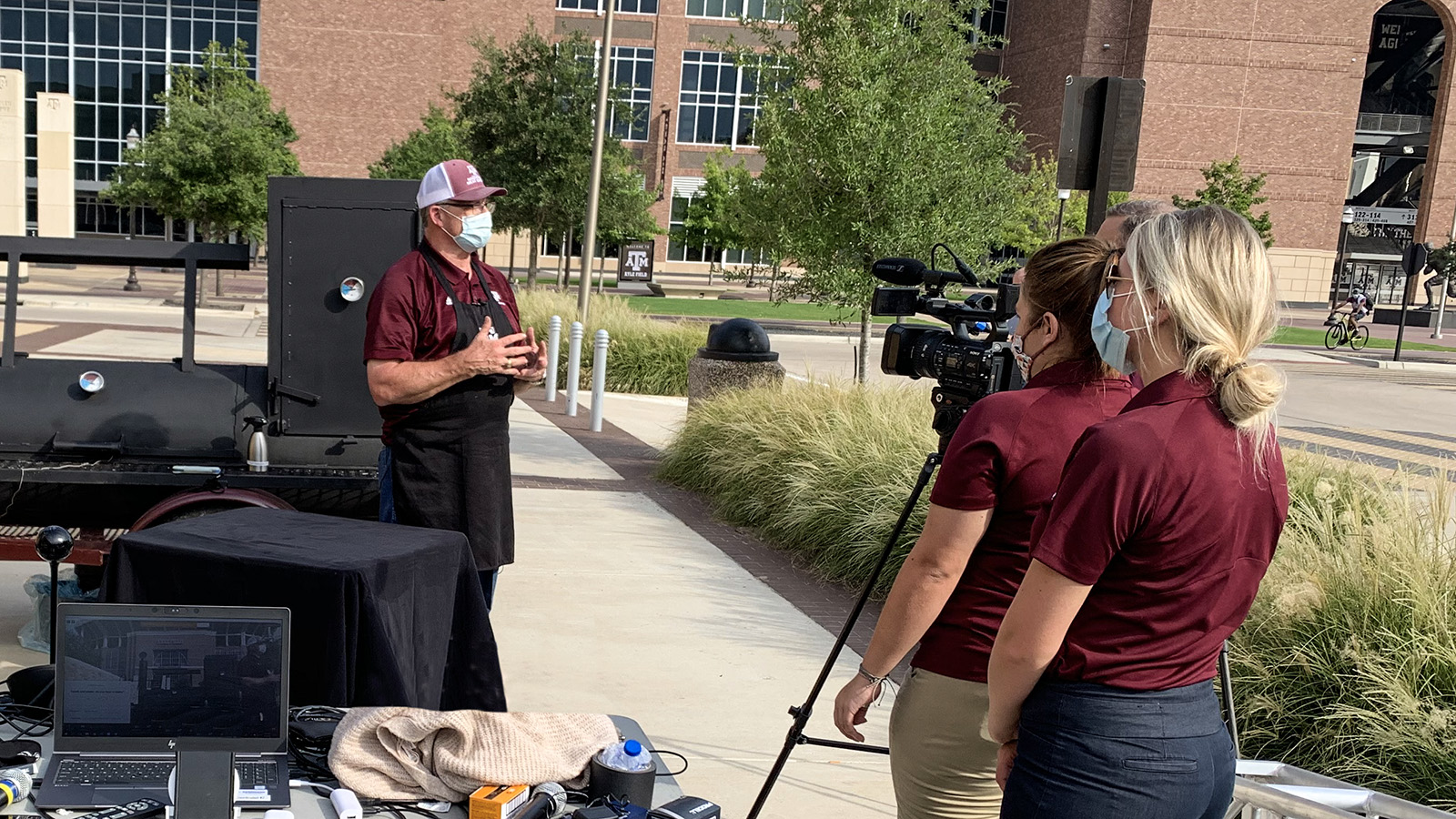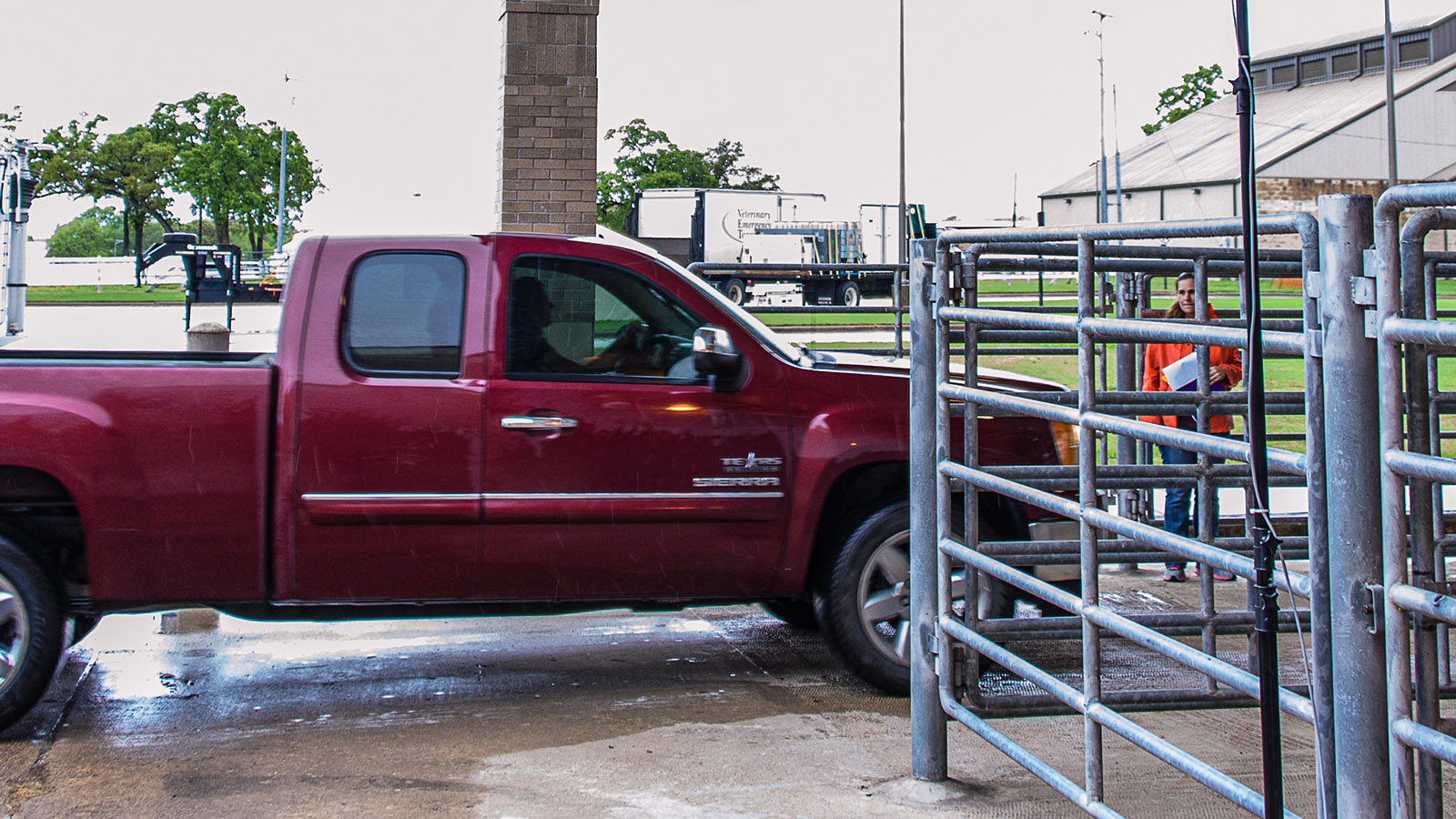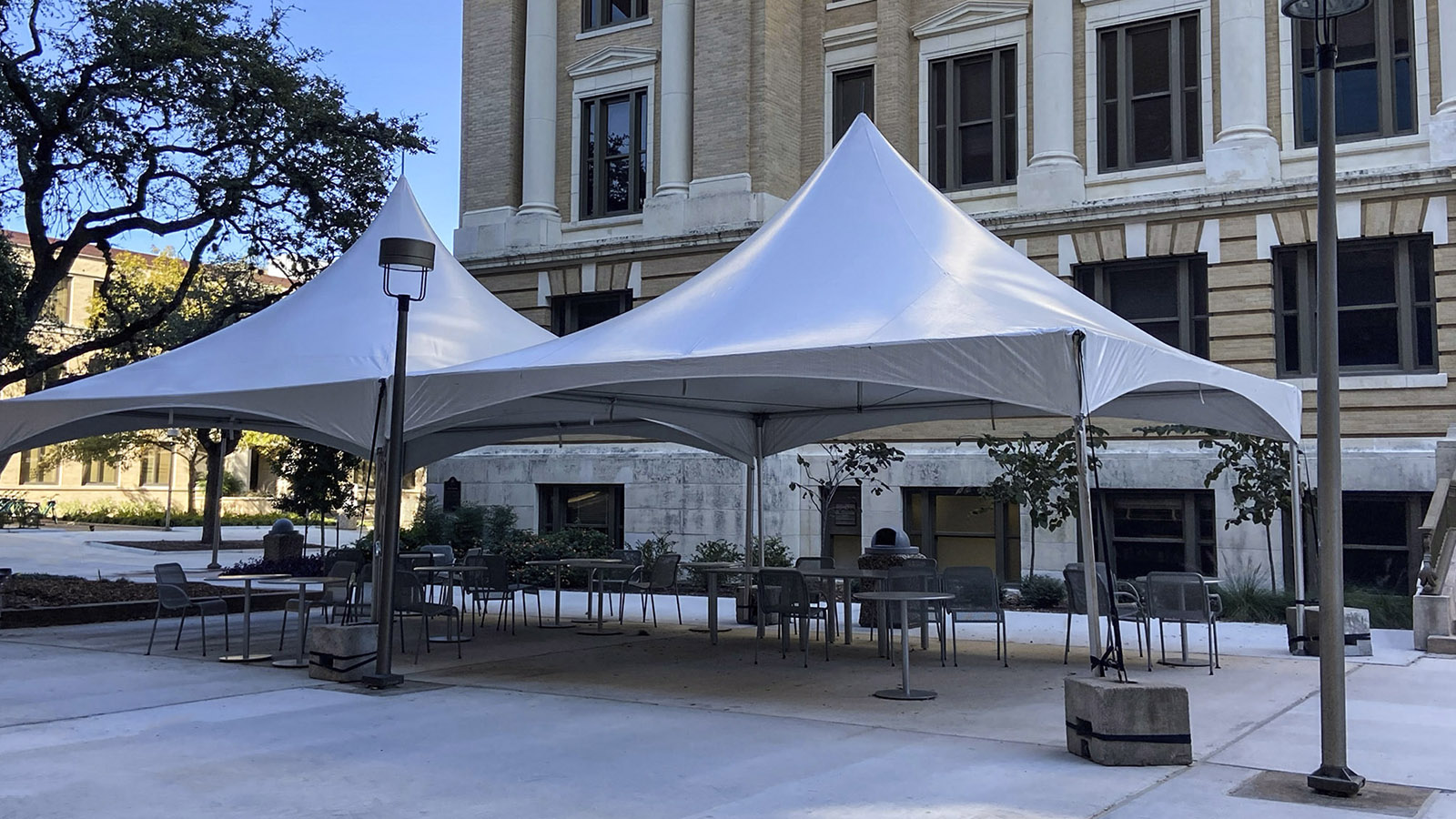Focused
Division Takes COVID Fight to the Cloud
Just as COVID was uncharted territory, so were the various areas Texas A&M and the Division of IT entered to fight the pandemic: testing, reporting and contact tracing.
The Division of IT, in partnership with TAMU Health, was charged with developing a COVID-19 dashboard for the campus community. The tool needed to ingest data from a number of sources, including self reporting through Research Electronic Data Capture (REDCap) databases and Curative testing data from campus walkup locations and other sources.
Joshua Kissee, Director of Research, Academic & Health IT Services, explained that development would have been more difficult had they not been using the Secure Technologies for Aggie Researchers (STAR) cloud environment in Amazon Web Services (AWS).
" [The dashboard] gave the administration direct visibility into what was happening on campus, so they could adjust for clusters and trends that were going the wrong way."

"We were able to create a cloud-based, serverless application to drive the dashboard thanks to AWS," he explained. "We already had a developer training on the environment, so we were able to get this running within three weeks."
The dashboard was also used by the Brazos Valley Health Department, KBTX-TV and other area media.
"This dashboard brought accountability and transparency to Texas A&M University and allowed students to decide if they felt comfortable attending class in person," Kissee said. "It also gave the administration direct visibility into what was happening on campus, so they could adjust for clusters and trends that were going the wrong way."
The Division of IT took the dashboard a step further by creating a specialized, internal dashboard using an Amazon business intelligence tool. The internal dashboard provided in-depth, graphical trends for compliance personnel, the provost, president and others.
Combating the virus through random testing and contact tracing
In June, the Division of IT was asked to create a contact tracing center in partnership with the School of Public Health (SPH). Three large rooms of Clinical Building 1 were converted for use by approximately 50 staff members to call anyone who self reported a positive test result or symptoms and those with whom they made contact. The tracing center became vital when the Provost asked the SPH to begin random testing of the Texas A&M community.
With a goal of testing 5,000 people every three weeks, SPH needed us to build a custom information system to send and track results.
"We worked with the University of Central Florida to modify a tool they already created," Kissee said. "This enabled us to quickly automate the sending of test results to our dashboard.
It was a lot of work, but we were excited to help the campus at such an important time. "
Division of IT retrofits non-traditional classrooms, enables social distancing
When the university announced the return of in-person classes for the fall, the Division of IT worked with university leaders to find and outfit many non-traditional spaces for learning - ensuring adequate social distancing. The network team met the challenge head on, installing Wi-Fi in meeting rooms, theaters, arenas and parking lots across campus - enabling the university to safely continue its mission.
Rudder Tower - Converted meeting rooms into classroom space. Added wireless coverage and wired internet ports for teaching lecterns.
Rudder Theater - Converted Auditorium, Theater and Forum into classroom spaces. Added wireless coverage and wired internet ports for teaching lecterns.
All Faiths Chapel - Added wireless coverage and wired internet ports for teaching lecterns.
Koldus Career Center - Added internet capabilities and upgraded bandwidth to the building to support remote student job interviews and practice with mentors.
Reed Arena - Added wireless coverage to the entire 'bowl' portion of the arena and wired internet ports for teaching lecterns.
College of Veterinary Medicine & Biomedical Sciences (CVM) - Outdoor wireless to support patient check-in and triage in Large Animal Hospital parking lot.
A.P. Beutel Health Center - Added outdoor wireless for COVID testing tents.
Garden Apartments Community Center - Adjusted and upgraded some wireless equipment to add classroom space and support social distancing for residents.
Annenberg Presidential Conference Center - Added wireless coverage and wired internet ports for teaching lecterns.
Student Recreation Center - Added wireless to rooms 2229A and 2229B to support in-person class attendance.
Mechanical Engineering Office Building (0392) - Added wireless to conference rooms to support in-person class attendance.
Memorial Student Center - Added access points to improve wireless coverage in large conference rooms to support in-person class attendance.
Sterling C. Evans Library outdoor area - Added wireless coverage for social distancing stations.

In August, the division deployed multiple point to point (PtP) wireless networks at the O. D. Butler, Jr. Animal Science Complex to support the Annual Texas A&M Beef Cattle Short Course. The PtP solutions were used to extend and provide network connectivity for live Zoom demonstrations that took place in open fields and cattle pens.
Division Helps VetMed Drive-Through Become Reality
Resilience was illustrated by the College of Veterinary Medicine & Biomedical Sciences (CVM) and the Division of IT in March when an outdoor network was set up to process and serve patients in a drive-through format. In just a three-month period, over 4,000 patients were served while exposure between pet owners and staff were minimized.
" We are so grateful for the Division of IT's assistance."

The Veterinary Emergency Team (VET), which provides veterinary care in disaster situations, set up equipment trailers in the parking lot of the Large Animal Hospital to provide triage, vaccinations and other medication delivery. While an ethernet cable was run from the hospital, the amount of equipment required a faster, more robust connection.
Kris Guye, CVM executive director of Information Technology and assistant chief information officer (CIO), said he emailed Dee Childs and asked if some ports could be activated on a Division of IT switch at the hospital and if temporary outdoor Wi-Fi could be provided. In less than six hours, the Division deployed a full-service network.
"The Division would have helped anyone, but I felt comfortable making the request thanks to the Assistant CIO program," Guye explained. "This program has greatly improved the communication, policy and leadership between 'central' IT and the College of Veterinary Medicine."
The setup was used for approximately three months, during which over 4,000 patients were served.
"Maintaining the best standard of care is our priority," said Dr. Jonathan Levine, head of the Small Animal Clinical Department. "Excellent patient care relies heavily on technology and our team needs access to their tools. We are so grateful for the Division of IT's assistance."
Innovation Prepares Texas A&M for Pandemic, Future
Texas A&M is known for innovation, and this quality allowed us to be one step ahead of the technological challenges posed by the pandemic. In two weeks, Texas A&M moved one of the largest campuses in the nation online, converting over 13,000 classes from in-person to online and moving its workforce off campus.
While many universities raced to purchase a virtual meeting platform to meet the demands of online learning, Texas A&M had already licensed Zoom. In addition, the Division of IT was piloting Microsoft 365, and with the push of a button, provided campus members virtual phones, messaging tools, and cloud-based file storage. Little did we know, these tools would soon be a part of daily life.
In January of 2020, approximately 5,000 Zoom meetings took place. As courses went virtual, Zoom sessions grew to about 130,000 sessions per month by April.

" Some may interpret the statistics as evidence of a new digital transformation. However, Vice President of Information Technology and Texas A&M Chief Information Officer Dee Childs says the transformation has been quietly taking place for some time. This transformation made the transition to online courses less painful."
"Many of us read books online now, something we didn't do 10 or 15 years ago," she said. "The 'digital natives' who are coming to Texas A&M today are accustomed to online books, streaming music, and probably experienced some online learning in K-12. So for many, this was just a natural transition."
Texas A&M Assistant Provost for Academic Innovation Jocelyn Widmer agrees and says the current transition is positive, since it is preparing the campus for the move to the Canvas Learning Management System.
Childs and Widmer agree this move to remote instruction will change higher education in many ways. Changes include campus operations extending beyond 8 a.m. to 5 p.m. and an expansion of virtual office hours. Another is a shift away from referring to a face-to-face or online course and instead classifying them as synchronous (live) or asynchronous (available to students on demand).
"We see these channels engage and captivate different audiences in ways that are not always possible in a face-to-face setting," Widmer points out. "Hybrid instruction is as much, if not more, about the choice of the learner and how they participate in instruction as it is about the choices made in designing and facilitating the instruction."
Childs agrees and points out that in-person offerings will always be important at Texas A&M.
"A reason we're one of the largest universities in the country is that students love the residential experience and want to be part of the Aggie community," she says. "We want to give students the best of both worlds."
Division Sets Up Connected "Social Distancing Stations" Across Campus
To deter the spread of COVID when students returned to campus, the Division of IT set up "social distancing stations" at 15 sites across campus, with tables and chairs set up under a total of 41 tents.
" Since students could not sit in the hallways between classes, the goal was to provide convenient outdoor study spaces."

Provost Carol Fierke requested the help of the division's Business Relationship Management (BRM) team, which consisted of Jana McDonald and Anthony JG Antonidis. McDonald said they scouted out locations that would serve the most students.
"Since students could not sit in the hallways between classes, the goal was to provide convenient outdoor study spaces," she said. "We also made sure the areas had at least two bars of Wi-Fi service. Our networking team also installed outdoor Wi-Fi for stations outside Evans Library."
In all, the Division of IT sourced 425 tables and 650 chairs, including 75 tables compliant with the Americans with Disabilities Act (ADA), on a very tight timeline when supplies for outdoor furniture were in very high demand.
Installation began the first week of the Fall 2021 semester. The tented areas will remain for the spring 2021 semester.